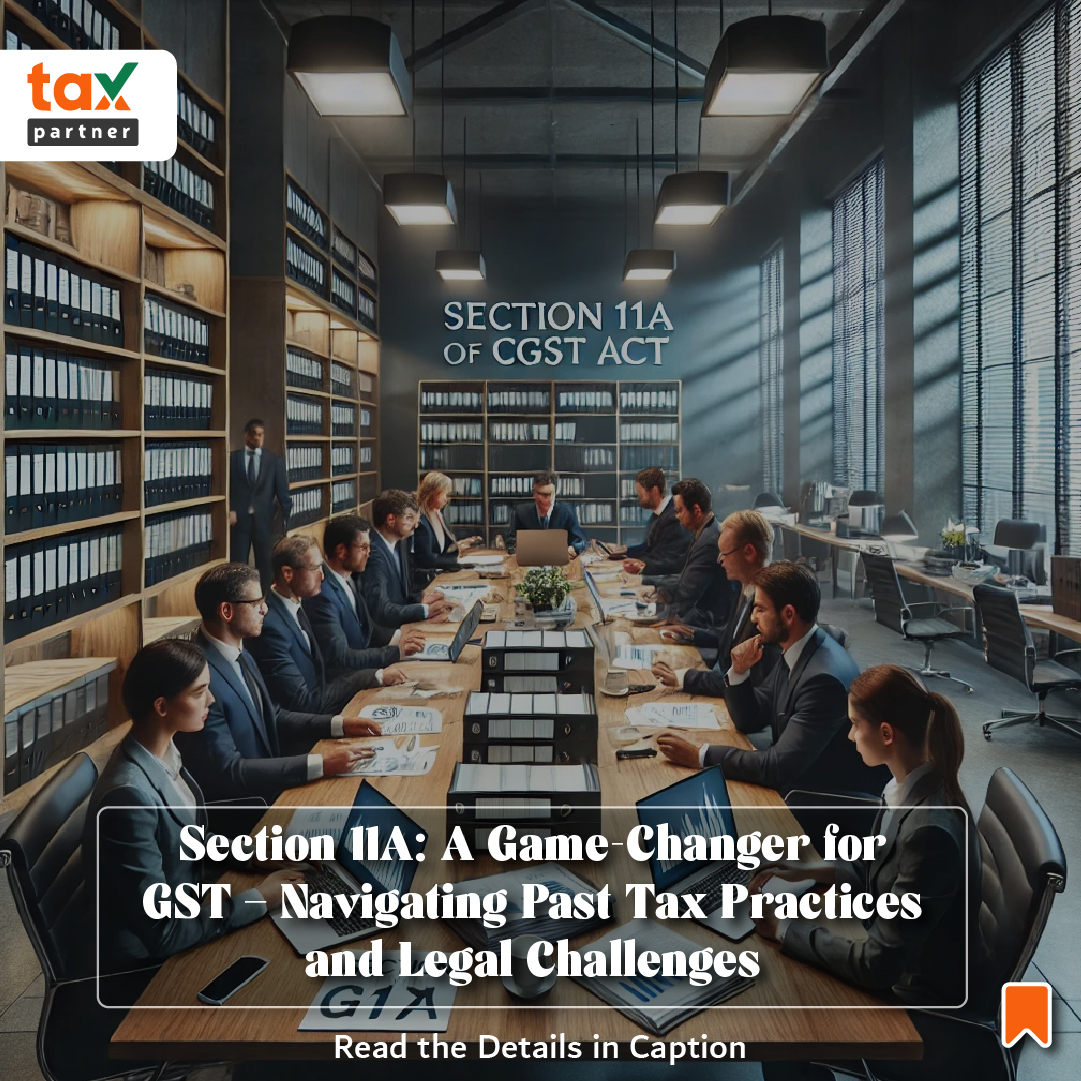Connect with us for all your queries



Since the Goods and Services Tax (GST) was introduced in India on July 1, 2017, businesses and taxpayers have encountered various challenges due to the complexity of the new tax system. The central goal of GST is to streamline indirect taxation and create a uniform tax regime. However, ambiguities in interpretation and genuine compliance errors have caused issues related to non-payment or short payment of GST. Over the years, the GST Council has issued multiple circulars to address interpretational ambiguities and provide relief by regularizing past practices. These efforts, while helpful, did not rest on a solid legal foundation, leaving many taxpayers in a precarious position.
Recognizing the need for clarity and to ensure fairness in tax administration, the Government of India introduced Section 11A in the Central Goods and Services Tax Act, 2017 (CGST Act). This new section aims to clarify the government’s authority to regularize GST non-recovery based on general trade practices. Effective from November 1, 2024, Section 11A provides the government with the power to waive the recovery of GST that was either not levied or short-levied due to generally prevalent practices. This article will provide an in-depth analysis of Section 11A, its implications, and the challenges that may arise from its application.
Background
In the initial years of GST implementation, numerous taxpayers encountered interpretational ambiguities, resulting in inadvertent non-payment or short payment of taxes. Businesses often relied on existing trade practices or industry norms, some of which were later deemed non-compliant under the GST framework. As these issues accumulated, taxpayers approached the GST Council, seeking relief from potential penalties and retrospective demands.
In response, the GST Council issued several circulars based on recommendations to regularize past practices. However, these circulars operated on an ad-hoc basis and lacked the legal backing to resolve disputes comprehensively. Moreover, the practice of issuing circulars to regularize past conduct raised concerns about their validity, especially since there was no explicit provision in the law empowering the government to adopt such measures.
Insertion of Section 11A
To address these challenges, the government introduced Section 11A in the CGST Act. The new section is modeled on similar provisions in other tax laws, such as Section 11C of the Central Excise Act, 1944, and Section 28A of the Customs Act, 1962. It empowers the government to waive the recovery of GST in cases where a common trade practice led to the non-levy or short-levy of tax. This section clarifies the government’s authority and provides a legal mechanism to address past compliance issues.
Section 11A reads as follows:
Power not to recover Goods and Services Tax not levied or short-levied as a result of general practice.
“11A. Notwithstanding anything contained in this Act, if the Government is satisfied that—
(a) a practice was, or is, generally prevalent regarding levy of central tax (including non-levy thereof) on any supply of goods or services or both; and
(b) such supplies were, or are, liable to,—
(i) central tax, in cases where according to the said practice, central tax was not, or is not being, levied, or
(ii) a higher amount of central tax than what was, or is being, levied, in accordance with the said practice,
the Government may, on the recommendation of the Council, by notification in the Official Gazette, direct that the whole of the central tax payable on such supplies, or, as the case may be, the central tax in excess of that payable on such supplies, but for the said practice, shall not be required to be paid in respect of the supplies on which the central tax was not, or is not being, levied, or was, or is being, short-levied, in accordance with the said practice.”
This provision allows the government to regularize instances of non-levy or short levy of tax due to common trade practices, thereby relieving businesses from potential litigation and back taxes.
1. Non-Obstante Clause
Section 11A begins with a non-obstante clause, meaning it overrides any conflicting provisions in the CGST Act. This ensures that in case of any legal dispute, Section 11A will take precedence over other provisions of the Act, thereby providing a clear legal framework for addressing cases of non-levy or short levy due to common trade practices.
2. General Prevalent Practice
The section focuses on situations where a “generally prevalent practice” led to non-compliance. This implies that the government recognizes that certain industry practices, though non-compliant with GST provisions, were widely accepted and followed. In such cases, the government may choose not to recover GST from businesses that followed these practices.
3. Waiver of Recovery
The primary purpose of Section 11A is to waive the recovery of GST that was not levied or was short-levied due to such practices. This waiver applies only to cases where the government is satisfied that the non-compliance was unintentional and arose from commonly followed trade practices.
4. Retroactive Application
Section 11A can apply to past transactions, providing relief to businesses that may have inadvertently underpaid or not paid GST due to misunderstandings about tax applicability. This retroactive application can help resolve many longstanding disputes and reduce litigation.
1. Reducing Litigation and Compliance Burden
One of the key objectives of Section 11A is to reduce the compliance burden on businesses and prevent unnecessary litigation. By regularizing past practices and waiving GST recovery in cases of common trade practices, the government aims to provide businesses with certainty and relief from potential penalties. This will help ease the compliance burden and create a more business-friendly environment.
2. Impact on Businesses
For businesses, Section 11A offers a mechanism to resolve past compliance issues without facing retrospective tax demands. Many businesses that followed industry norms or relied on interpretations of the law that were later found to be incorrect can now benefit from the waiver of GST recovery. This is especially important for small and medium-sized enterprises (SMEs) that may not have the resources to engage in prolonged litigation.
3. Addressing Interpretational Ambiguities
The introduction of Section 11A also helps address interpretational ambiguities in the GST law. Over the years, various industries have encountered issues where the law was unclear, leading to inconsistent practices. Section 11A provides a legal framework to regularize these practices, thereby resolving uncertainties and promoting consistency in GST compliance.
4. Preventing Future Non-Compliance
While Section 11A addresses past non-compliance, it also serves as a deterrent for future non-compliance. By clarifying the government’s authority to regularize common trade practices, the section encourages businesses to adhere to GST provisions more closely and avoid relying on ambiguous interpretations of the law.
1. Lack of Refund Provisions
One of the most contentious issues arising from Section 11A is the lack of provisions for refunds. According to the section, taxpayers who paid GST on transactions that were not subject to tax due to general trade practices are not eligible for refunds. This is particularly problematic for businesses that complied with the law as it stood during the period from July 1, 2017, to October 31, 2019.
2. Potential for Litigation
The denial of refunds for taxes paid on non-taxable transactions raises concerns about the legality of tax collection under Article 265 of the Constitution, which states that no tax shall be levied or collected except by the authority of law. Businesses that paid GST on transactions later deemed non-taxable may argue that they are entitled to refunds. This could lead to legal challenges and potential disputes over the government’s authority to deny refunds.
3. Applicability of Section 11A
Another potential challenge is the scope and applicability of Section 11A. The section applies only to cases where non-compliance was due to a “generally prevalent practice.” Determining whether a practice was genuinely widespread and accepted within the industry may be subjective and could lead to disputes between taxpayers and tax authorities.
4. Fairness and Legal Authority
While Section 11A provides relief to businesses, it also raises questions about fairness and legal authority. Businesses that complied with the law and paid taxes on time may feel that they are being penalized by not being eligible for refunds, while those that did not pay taxes benefit from the waiver of recovery. This could create a perception of inequity in tax administration and lead to dissatisfaction among compliant taxpayers.
Section 11A of the CGST Act is modeled on similar provisions in other tax laws, such as Section 11C of the Central Excise Act, 1944, and Section 28A of the Customs Act, 1962. Both of these sections empower the government to waive the recovery of duties that were not levied or short-levied due to general trade practices.
The key difference between these provisions and Section 11A is that the latter applies to the GST regime, which is a comprehensive indirect tax system covering goods and services. The complexity of GST and the widespread impact of interpretational ambiguities make Section 11A even more significant in resolving compliance issues.
The insertion of Section 11A in the CGST Act is a significant step towards addressing the challenges faced by taxpayers due to interpretational ambiguities and non-compliance under the GST regime. By providing the government with the power to waive the recovery of GST in cases of general trade practices, Section 11A offers much-needed relief to businesses and helps reduce litigation and compliance burdens. However, the lack of refund provisions and the potential for future legal challenges remain concerns that need to be addressed.
For businesses, it is essential to stay informed about the implications of Section 11A and seek professional advice to ensure compliance with GST provisions. Tax authorities must also ensure that the application of Section 11A is fair, transparent, and consistent to avoid disputes and promote a business-friendly environment.
Tax Partner is India’s most reliable online business service platform, dedicated to helping you in starting, growing, & flourishing your business with our wide array of expert services at a very affordable cost.